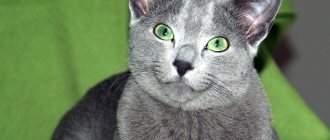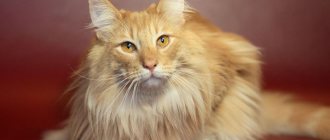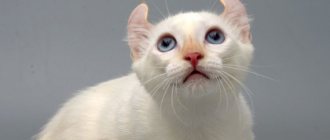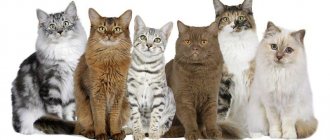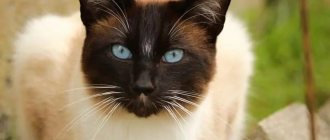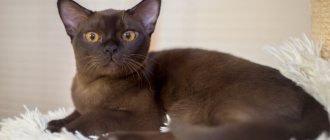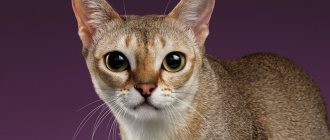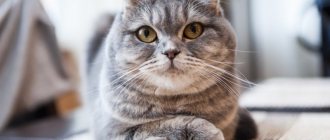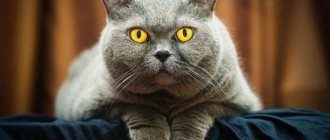“Moon Diamonds,” or Siamese cats, appeared in Europe at the end of the 19th century and since then have confidently held the palm among the most popular breeds. And this is no coincidence: Siamese are notable for their unusual color, expressive physique and interesting character. Therefore, breeders began to breed new breeds that are similar in appearance to the Siamese cat. However, they all have their own, unique features both in appearance and character.
Siamese cat
The Siamese cat is a popular short-haired breed with a recognizable point color. Unique beauty is combined with sociability and intelligence. A good companion for those who value open expression of feelings and constant connection with their pet. These talkative cats will not let you get bored and will participate in all family activities.
| Breed | Siamese cat |
| Type | Siamese-oriental (eastern) group |
| Country of origin | Thailand |
| Coat | Shorthair |
| Lifespan | 15 – 25 years |
| Kitten price | 8000 – 35000 rubles |
History of the origin of the Siamese breed
The Siamese cat is one of the oldest and most famous cat breeds. Despite this, the origin of Siamese cats is still considered a mystery.
The manuscript "Book Poems about Cats", dating back to 1350 - 1700, discovered in ancient Siam (modern Thailand), describes a pale cat with a dark coloration of the face, paws, ears and tail. According to legend, the Siamese were considered sacred. When a member of the royal family died, his soul was possessed by a Siamese cat, which then lived in the temple in luxury with monks and priests as servants. The theft and killing of a Siamese cat was punishable by death. Uncontrolled crossbreeding of Siamese in the 19th and 20th centuries led to cats no longer meeting the breed standard. Modern Siamese have become thinner and have acquired a characteristic triangular muzzle.
Subsequently, Siamese cats quickly became popular in different countries. This breed was first seen in Europe in 1871 at the London Cat Show. In 1879, a Siamese cat was given to the wife of the US President. The Siamese Cat Club was formed in 1901 in Great Britain, and the Cat Fanciers' Association (CFA) recognized the breed in 1906.
- Oriental cat. The Balinese cat is a semi-longhaired Siamese cat. Burmanskaya. Thai is a restored Siamese breed according to the old type standard. The Himalayan is a long-haired breed developed by crossing Siamese and Persians.
Differences between Siamese and Thai breeds
Attitude towards children
Both breeds are tolerant of children: they quickly adapt to living in a large family and tolerate children's pranks well. Nevertheless, Thais are more friendly towards children, as they are not jealous and get along well with other family members.
Siamese become attached to one owner and will be jealous of everyone else - this also applies to children. In addition, Siamese cats are characterized by touchiness, after which it is difficult for them to make contact with anyone other than the owner.
A wayward Siamese may be jealous of his owner's child
Description of the Siamese breed
Let's look at the appearance and character of Siamese according to the breed standard.
Standard
Siamese cats are well balanced, boasting an athletic, flexible body and elegant, slender legs.
The breed standard for the modern Siamese cat assumes:
- Body: Elongated, tubular and muscular. A typical Siamese cat has a total height of 20-25 cm and a body length of 29-36 cm, with a body weight of 4-5 kg. Head: Straight profile with a strong chin and a pleasant, even bite. The head forms a perfect triangle from the tip of the nose to each tip of the ear. The neck is long. The eyes are almond-shaped, bright blue, and the ears are large, wide, located closer to the head. Limbs: The cat's hind legs are longer than her front legs, which adds to her athletic and graceful appearance. The paws are oval shaped and small. Thin tail. Coat: Short, shiny, fine coat without undercoat that lies close to the body.
Today, there are over 20 varieties of Siamese cat colors all over the world, and the most famous of them are:
- Seal point (brown or cream), with a cream-colored body and dark brown pigments on the nose and paws. It is believed that this was the original color of the breed when it was first exported from Siam (Thailand). Blue Point (blue) - the body is snow-white with a bluish tint, as well as a gray nose and paws. The Red Point is a white body with red (apricot) pigments on the nose and paws. The Caramel Point (light cream) is considered a hybrid due to a complex breeding process, with very light and pink pigments on the nose and paws. Chocolate point (black). The body is cream or milky in color, and the pigments on the points can range from chocolate to black. Cinnamon point (ivory). The body is ivory-colored, like a Chocolate Point, but the markings on the nose and paws are pinkish-brown.
Photos of colors
Character of Siamese
Siamese are known for being one of the most intelligent and vocal cats in the world and will happily spend time with their owners. Siamese cats are affectionate with domestic cats, however, they can be demanding and suspicious of strangers. Many people say that their Siamese pets greet strangers at the door and go through some kind of approval process before visitors enter the house.
At the same time, Siamese cats are very active and love active games with toys. When it comes to training, they do not have any special exercise needs because Siamese cats are very active and playful in their own right.
They quickly get accustomed to the litter box and scratching post; the main thing is not to shout or force the cat to do anything. Siamese are quite proud and can become stubborn from such treatment. You can even toilet train them if you start training them when they are young.
You should not get a Siamese cat if you are often away from home. The pet will get bored and entertain itself in any of the available ways.
The stereotype about the evil character and vindictiveness of the Siamese, as a distinctive feature of the breed, originated in the USSR. The price of a purebred Siamese cat was high, so we usually received rejected kittens with squints, creases in the tail and abnormalities.
Health
With proper care and nutrition, the average lifespan of Siamese cats is 15-25 years.
They may also have problems with progressive retinal atrophy, which can lead to poor vision and even blindness. Glaucoma and strabismus are also common among eye diseases.
This breed is more prone to lung infections than others. The most common condition is asthma, which causes inflammation and narrowing of the lungs' airways.
These cats are known to have very sensitive stomachs. In addition, Siamese cats may have problems with the heart, kidneys and liver.
Diseases, their prevention and treatment
Mixed-breed cats are generally healthy animals; their susceptibility to diseases depends on their phenotype:
- The “marquise” phenotype has excellent health, but if there is a malnutrition, urolithiasis develops.
- Representatives of the “Siberian cat” phenotype often experience digestive difficulties and are prone to rapid weight gain, diabetes and urolithiasis.
- Angoras have good health, but some individuals have breathing problems.
- In the “Persian” phenotype, diseases of the upper respiratory tract and genitourinary system are observed.
- Representatives of the “oriental” phenotype rarely get sick, but sometimes they are diagnosed with gastrointestinal diseases.
- “Thais” have good health, but some individuals are predisposed to urolithiasis and infectious diseases.
- “The British” are prone to chronic kidney disease, obesity, and suffer from endocrine system disruption and chronic pancreatitis.
Treatment is prescribed exclusively by a veterinarian after a series of diagnostic and laboratory tests.
Prevention of infectious diseases involves timely vaccination, which must be carried out even if your pet does not go for walks in the yard. We bring viruses and bacteria home on the soles of our shoes; mating with animals without a veterinary passport means an increased risk of contracting a genitourinary infection.
According to the vaccination calendar, pets are vaccinated according to age against the following diseases:
- Rabies is an infectious disease that has no cure. Carried by infected animals and rodents.
- Rhinotracheitis is a herpesvirus infection that affects the respiratory system and eyes. Characterized by an acute course. Carriers are sick cats.
- Calcivirosis is an infectious disease transmitted from other cats. Mortality is more than 80%.
- Peritonitis is a disease caused by coronavirus. The route of infection is airborne. Mortality is more than 90%.
- Panleukopenia or feline distemper. – an acute viral disease transmitted from sick cats. Difficult to treat, leads to death in 90% of cases.
- Chlamydia is an infectious disease characterized by a long course, transmitted by birds and rodents, and affects the genitourinary, visual, respiratory, and digestive systems.
- Microsporia or ringworm is a skin disease transmitted from sick animals, as well as from cats to humans.
- Panleukopenia, chlamydia, calcivirosis, rhinotracheitis - at 8 weeks, revaccination at 10-12 weeks, then annually.
- Rabies - at 12 weeks, revaccination every year.
- Microsporia - at 8 weeks, revaccination after 14 days, then annually.
- Viral peritonitis - at 16 weeks, revaccination after 4 weeks, then every year.
Breed card
| Characteristics of a cat | Notes | |
| General information | An ancient cat breed known for its pointing color, playfulness and ringing voice. Extroverts by nature | Modern Siamese are the result of restoring the standard of an ancient breed. And those yard cats, which in Russia are usually mistaken for Siamese, are representatives of the Thai breed |
| Character | Siamese require their owner's attention constantly. They have an affectionate nature and are quick-witted, but can be stubborn | Purchase various toys in advance so that your pet always has something to occupy himself with. |
The best solution would be to purchase a gaming complex for cats
They are incredibly clean and don't shed much, so caring for them is not particularly difficult.
Wool
Even though Siamese cats have short hair, they need to be brushed weekly. Many fans of this breed recommend small rubber brushes. You need to comb in the direction of hair growth.
Most Siamese cats are very clean and clean themselves well, so you can bathe them no more than 2 times a year. However, when they are very dirty or have gotten into something sticky, they may need a little help.
Advice! Place a rubber mat in the sink or bathtub to prevent your cat from slipping.
Nutrition
In addition to basic veterinary care such as vaccination compliance and regular checkups, proper nutrition is important. Providing a proper diet can help prevent health problems in your pet later in life.
Advice! Don't forget to change the water and wash the bowls daily!
There are two options for feeding your pet: natural food and industrial food.
Natural nutrition
The basis of nutrition is animal proteins:
- Lean meats (chicken, rabbit, lean beef and turkey). Sea fish and seafood (tuna, cod, shrimp) - as a source of healthy fats and taurine. Eggs (preferably quail) – no more than once a week. Beef liver and offal - tripe, udder, lips, chicken necks.
Carbohydrates and fats
:
- Fermented milk products - cottage cheese, ryazhenka kefir, yogurt without additives. Vegetables and greens - zucchini, carrots, spinach, pumpkin, broccoli, peas, beets. Porridge – buckwheat, millet, oatmeal, rice. Linseed oil.
Vitamins – additional vitamin complexes are required for natural nutrition. Main additives: taurine, tetravit, calcium and yeast as a source of B vitamins.
Important! Red meat and liver can darken light fur, so you should not make such foods the main food for show cats.
Industrial feed
The basic rule is not to feed your pet economy-class food. The ideal option would be brands from the super-premium and holistic categories. We have previously compiled ratings for dry and wet cat food.
Recommended brands:
Orijien Fit & Trim. Acana Light & Breed. Go Natural. Eukanuba Sterilized. Bosch Sanabelle. Royal Canin “Sterilized 37”.
Sometimes cats are allergic to grains, cow's milk and poultry. In such cases, it is necessary to switch to grain-free lines such as Natural & Delicious, which are free of rice, corn and chicken.
Adult pets with certain diseases (diabetes, urolithiasis, renal failure and heart pathologies) are transferred to specialized veterinary nutrition. A good line of medicinal foods is represented by the Hill's Prescription Diet brand.
Vitamin-mineral complexes are not needed, because manufacturers necessarily include all the compounds necessary for the body in the feed.
Caring for ears, eyes, teeth and claws
- If possible, you should brush your cat's teeth 2 times a week. We revealed all the nuances of this simple procedure in this article. The almond shape of the eyes allows pus and tear fluid to accumulate in the corners, so be sure to wipe your eyes with a damp cotton pad as needed. Ears should be wiped with a barely damp cotton pad once a week. If you notice black spots, crusts and an unpleasant odor, take your pet to the doctor. The most common cause of such symptoms is ear mites, which are easily eliminated in the initial stages. If left untreated, it can lead to hearing loss.
A visit to the veterinarian every year is mandatory for keeping a Siamese cat. Examinations provide an opportunity to early detect health problems, including those that may change your cat's care needs. For example, viral diseases, eating disorders, heart and kidney problems.
The frequency of visits to the veterinarian depends on the age of the pet:
- kitten 1-4 months – monthly visits; 4 months to 7 years – 1-2 times a year; 7-10 years – twice a year; over 10 years old - visit every 3 months or more often, as age-related health problems only increase.
Walking your pet
Siamese cats are ideal pets for both apartments and country houses. They are perfectly adapted to travel and trips, because the main thing for these creatures is the presence of their beloved owner nearby. Cats are good travel companions when they are happy. Your job is to figure out how to make their journey comfortable. Bring your favorite bed, litter box, toys, food and litter box.
They can also be easily trained to walk outside in a harness or in a walking carrier.
Special Needs
Kittens need to be vaccinated in accordance with the vaccination schedule, that is, from the age of two months. It is also necessary to treat for parasites, because the kitten can even get them through the placenta or through mother's milk. Consult your veterinarian regarding the best anti-parasitic medications.
You may also experience behavioral problems after you adopt a kitten. In this case, it is very important to understand why the problem occurred in order to fix it.
Tonkinese cats require socialization, starting from childhood. Cats that are not properly socialized may begin to avoid contact with people.
Introduce the new family member to the rest of the pets gradually, over several days. They need to sniff each other, gradually increase the time spent together. At first, meetings should be short, then, if both animals are calm, you can increase the time. In this situation, patience and calm are needed.
Be sure to consider sterilizing your pet. Keep in mind that your cat needs to stay away from poisonous plants, electrical wires and other aggressive animals. Cats are carnivores and need a high-quality diet and access to fresh water every day. Physical activity can be provided through games and running. A sedentary lifestyle can lead to obesity and health problems in the future. Before adopting a kitten, evaluate the level of responsibility that will fall on you.
How to choose a kitten
When choosing a Siamese kitten, the most important things are its health and pedigree. Therefore, it is imperative to see the kittens’ parents and find out about their general health. Any mention of heart or liver problems in either parent should be noted as these can be passed on to the kittens.
You should also look at the place where the kittens are kept to make sure that they are free of dirt, fleas and ticks. Siamese kittens are social and quite dependent on their parents.
Therefore, kittens should not be weaned from their mother before 12 weeks of age, otherwise they may develop severe anxiety disorders.
You may notice that the kittens are either creamy white or lighter in color than expected. This is fine. The face, paws and tail darken at about 4 weeks of age and continue to darken until the kittens are 1-2 years old. The size of the points directly depends on the temperature of the habitat. The lower the temperature, the more the coat darkens.
That's why newborn kittens, warm from their mother's womb, are white everywhere. Then, as they grow at normal temperatures, the hottest area of their body, around the belly and back area, remains pale while the limbs gradually become darker. And in an adult cat, the general body temperature begins to drop somewhat, and over time the fur darkens more and more.
As for the cost of a kitten , this indicator depends on the following factors: age, pedigree, health status, availability of vaccinations, travel box, toys, etc. Also of great importance is the owner’s guarantee that her parents do not suffer from any serious diseases that could be inherited by the kitten.
- The price of a pet-class kitten (pet) is 3000-8000 rubles. Breeding class (breeding) – 10,000-15,000 rubles. Show class (show kittens) – the price depends on the nursery, from 30,000 rubles and above.
Nutritional Features
The diet of mestizos is no different from the diet of purebred cats. Considering that felines are obligate animals, the main ingredient in their menu should be meat. In second place are animal fats, in third place are carbohydrates in minimal quantities.
Cats can be fed natural foods:
- rabbit or lamb meat;
- chicken;
- turkey;
- veal;
- chicken giblets;
- sea fish;
- greens;
- fresh vegetables;
- eggs;
- fermented milk products.
You should not give salted, fried, spicy, sweet foods, whole milk, river bony fish, tubular bones. Forbidden delicacies cause excess weight gain, metabolic disorders, and failure of the endocrine, cardiovascular, and urinary systems. Buy treats at veterinary pharmacies or pet stores.
Meals are selected individually. Energy value and nutrient requirements depend on:
- physiological state of the cat (pregnancy, castrated and sterilized animals);
- body weight, constitution;
- health conditions;
- age;
- conditions of detention;
- activity level.
Breeding
If you decide to start breeding a Siamese cat, the first step is to find a healthy male. Of course, the best way to do this is to contact the owner of a nursery near where you live. A Siamese cat owner with a good pedigree will be happy to help you in this matter, as he knows how important it is to keep the blood lines pure and reduce the risk of any hereditary problems.
When choosing a breeding cat for your Siamese breed, consider the following factors:
- Is this the first time your female will be mating? If the answer to this question is yes, then you should think about having an experienced male. Have you had all the necessary tests? Before you take your cat for mating, you should arrange a visit to the veterinarian to confirm the absence of hereditary and viral diseases. What are you going to do with the kittens? When choosing a breeding cat, you need to make sure that you can sell the kittens in the future.
Pregnancy in Siamese cats is slightly shorter than other breeds - 58-65 days. On average, a Siamese cat gives birth to 4 to 6 kittens. The colors of kittens can be predicted in advance by knowing the recessive and dominant genes for coat colors in both partners.
Siamese catteries in Russia
The Siamese breed is one of the most numerous, so finding a nursery is not difficult at all:
Interesting facts about the Siamese cat
- The color of their coat is determined not only by heredity. This breed has a special modifier gene that prevents the development of pigment in the fur, which leads to albinism. Siamese are considered one of the oldest cat breeds in the world. Legends say that in ancient times the first Siamese cats were tasked with guarding the royal cup. They looked at him with such intensity that their eyes crossed. For added security, the cats wrapped their tails around the cup, causing them to become permanently bent. Siamese cats have appeared in many Hollywood films.
Overall, this is the most affectionate cat breed you will find. She is very smart, obedient and friendly, and also loves and values human communication so much that she is even called a cat-dog.
Metis or mongrel?
True purebred cats are significantly inferior in number to outbred and mestizo cats, the difference between which lies not only in color, but also in behavior and health. As a result of family ties that were carried out for improvement, purebred cats have numerous mutations and a number of congenital pathologies. Mestizos and outbreds are distinguished by stronger physical characteristics and immunity.
Outbred cats often have short hair, which helps with hygiene. The most common color is brindle, but tortoiseshell, blue, spotted and solid are also found. According to their external characteristics, yard cats can be divided into northern and southern types. Those living in the north are distinguished by thicker, lighter hair and stocky, large physiques, while those living in the south are darker, smoother and more graceful.
A mixed-breed cat is also a mongrel cat, but has the characteristic features of purebred cats. This is manifested in color and physique, character and health. Mixed breeds have a chance to get the breed. To do this, the owners need to breed offspring from a mixed-breed parent couple (not father and mother, but of the same breeds) and cross the offspring with each other. And only the fifth generation can become a contender for thoroughbred.
